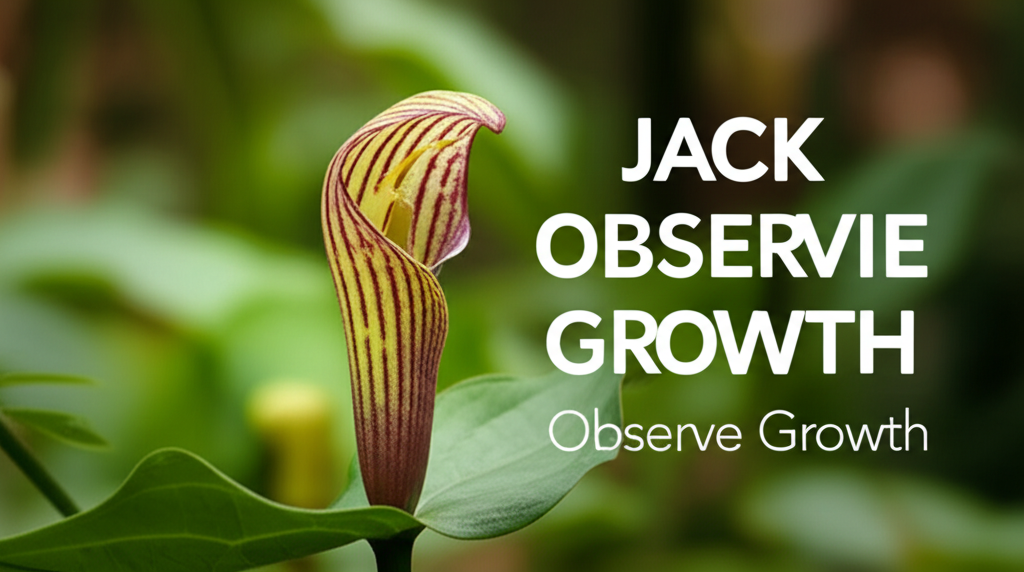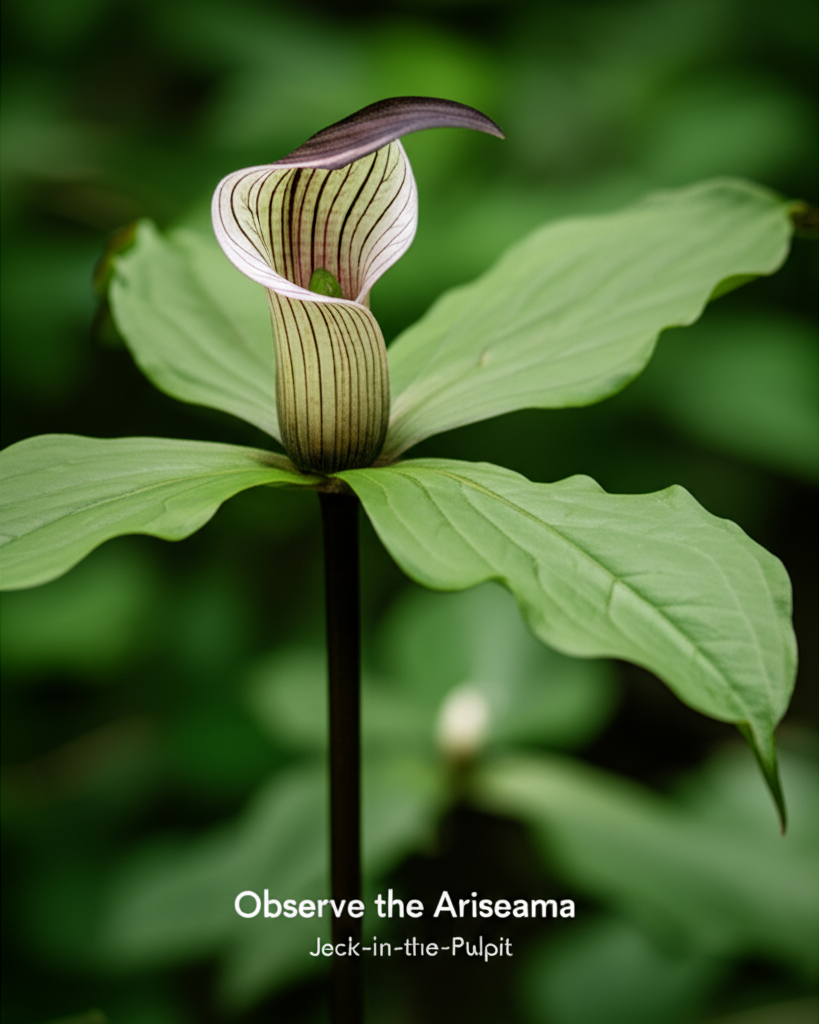Unveiling the Enigmatic Jack-in-the-Pulpit: A Gardener’s Delight
The Jack-in-the-Pulpit, scientifically known as Arisaema triphyllum, is a plant that captivates the imagination. Its unique and intriguing flower structure, resembling a preacher in his pulpit, makes it a must-have for any woodland garden or shady corner. Beyond its aesthetic appeal, observing this native perennial throughout the year offers a fascinating glimpse into the intricate cycles of nature. This guide will equip you with the knowledge to appreciate and document the seasonal journey of the Jack-in-the-Pulpit in your own garden, from its emergence in spring to its dormancy in winter.
Understanding the Jack-in-the-Pulpit’s Life Cycle
Before diving into seasonal observations, it’s crucial to understand the fundamental life cycle of the Jack-in-the-Pulpit. This plant is a cormous perennial, meaning it stores energy in a swollen underground stem called a corm. It typically grows in moist, shaded woodlands and thrives in rich, organic soil. One of the most remarkable aspects of the Jack-in-the-Pulpit is its sex change. Plants are often dioecious (having separate male and female plants), but individuals can transition from male to female over time, depending on environmental conditions and resource availability. This phenomenon adds another layer of intrigue to your garden observations.
Spring Awakening: The Emergence of the Preacher

Spring is arguably the most exciting time for Jack-in-the-Pulpit enthusiasts. As the snow melts and the forest floor begins to stir, so too does this remarkable plant.
Early Spring Emergence (Late March – April)
The first signs of life from the Jack-in-the-Pulpit usually appear in late March or early April, depending on your climate. Look for:
- The First Shoot: A tightly coiled, green shoot will push through the leaf litter. It often appears somewhat pointed, like a spearhead.
- Unfurling Leaves: Within a few days, the shoot will unfurl into the characteristic trifoliate leaves. Each leaf is divided into three leaflets.
- The Budding “Pulpit”: The flower stalk, or spathe, will begin to emerge alongside the leaves. It will be a green, hooded structure that gradually elongates.
Observation Tip: Mark the location of your Jack-in-the-Pulpits in the fall before they die back. This will help you easily locate them in early spring and avoid disturbing emerging shoots.
Mid-Spring Blooming (April – May)
This is when the magic truly happens. The spathe, or “pulpit,” opens to reveal the spadix, or “Jack.”
- Spathe Development: The spathe will continue to grow, often reaching several inches in height. Its color can vary from deep green to reddish-purple or brown, sometimes with stripes. The hood typically curls backward, creating the pulpit-like appearance.
- Spadix Emergence: The spadix, a fleshy spike, will emerge from within the spathe. Its color and shape also vary, but it’s often darker than the spathe.
- Pollination and Insect Visitors: The spathe acts as a trap, attracting small insects like gnats and flies with its scent and potentially by trapping them inside. These insects are crucial for pollination. Observe which insects are attracted to your plants.
Observation Tip: Document the color variations of your Jack-in-the-Pulpits. Note any unique patterns or markings on the spathe and spadix. This can be a good indicator of genetic diversity or environmental influences.
Late Spring Growth (May – June)
As the blooming period concludes, the plant focuses on vegetative growth and fruit development.
- Seed Head Formation: After pollination, the spathe and spadix will wither, and the plant will begin to form a cluster of bright red berries. These berries are held on the spadix.
- Leaf Maturation: The leaves will continue to grow and photosynthesize, providing energy for the corm.
Observation Tip: Take photos of the developing berries. Note the progression of their color from green to a vibrant red.
Summer: Maturity and Fruiting
Summer is a time of quiet growth and the maturation of the plant’s reproductive structures. The striking visual of the Jack-in-the-Pulpit is now replaced by the promise of new life in the form of berries.
Early to Mid-Summer (June – July)
The Jack-in-the-Pulpit is fully established in its summer form.
- Berry Development: The berries will swell and ripen, often forming dense clusters along the spadix. Their bright red color is a signal to birds and other wildlife that they are ready for consumption.
- Leaf Appearance: The leaves will be fully expanded and a healthy green, though they may begin to show signs of wilting as the soil dries out, especially during hot, dry spells.
Observation Tip: Keep an eye out for birds and squirrels feeding on the berries. This is a natural part of the plant’s dispersal strategy.
Late Summer: Preparing for Dormancy (August – September)
As summer begins to wane, the Jack-in-the-Pulpit starts to prepare for its dormant period.
- Berry Dispersal: Many of the berries will have been eaten by wildlife by this point. You may still see some remaining on the spadix.
- Leaf Yellowing and Dieback: The leaves will begin to turn yellow and eventually wither and die back. This is a natural process as the plant draws nutrients back into its corm for the following year.
Observation Tip: Note the approximate date when your Jack-in-the-Pulpits begin to die back. This will help you predict their emergence in the following spring.
Autumn: The Seed Dispersal and Quiet Retreat
Autumn is a period of transition for the Jack-in-the-Pulpit, marked by the final stages of seed dispersal and the plant’s graceful retreat into dormancy.
Early to Mid-Autumn (September – October)
The landscape transforms, and the Jack-in-the-Pulpit prepares to rest.
- Fallen Foliage: The dead leaves and flower stalks will lie on the ground, contributing to the rich organic matter of the woodland floor.
- Remaining Berries: Any berries that haven’t been consumed will likely be shriveled or have fallen.
Observation Tip: This is an excellent time to observe the role of the Jack-in-the-Pulpit in the ecosystem. Note how its fallen material enriches the soil and provides habitat for small creatures.
Late Autumn: Complete Dormancy (November)
By November, the Jack-in-the-Pulpit has completely entered its dormant phase.
- Underground Corm: All above-ground parts of the plant have died back, and the energy is stored within the underground corm, awaiting the signal of spring.
Observation Tip: Consider lightly mulching around the dormant plants with fallen leaves or compost to protect the corms and provide nutrients.
Winter: A Hidden Presence
While the Jack-in-the-Pulpit is not visibly present in the garden during winter, its importance in the ecosystem continues.
Winter Dormancy (December – February)
The garden may be covered in snow or frost, but the Jack-in-the-Pulpit is merely resting.
- Underground Life: The corm is protected beneath the frozen soil, conserving energy.
- Soil Health: The decomposing organic matter from the previous year’s growth continues to improve soil structure and fertility.
Observation Tip: Winter is a good time for planning and research. Consider where you might want to add more Jack-in-the-Pulpits, or research different varieties and their specific needs.
Key Facts and Comparison of Seasonal Stages
To better track your Jack-in-the-Pulpit’s progress, here’s a table summarizing its key characteristics throughout the year.
| Season | Key Observations | Typical Timing | Visual Appearance |
|---|---|---|---|
| Spring | Emergence of shoot, leaf unfurling, spathe and spadix development, blooming, insect attraction, berry formation begins. | Late March – June | Green shoots, trifoliate leaves, hooded spathe, spadix, developing red berries. |
| Summer | Berry ripening and dispersal, leaf maturation, potential wilting during dry spells. | June – August | Fully developed green leaves, bright red berry clusters, fading flower structures. |
| Autumn | Leaf yellowing and dieback, berry dispersal completion, plant enters dormancy. | August – October | Yellowing and dying leaves, fallen foliage, shriveled or absent berries. |
| Winter | Complete dormancy, corm stored underground, soil enrichment from decomposition. | November – February | No visible above-ground growth, dormant corm. |
Tips for Successful Jack-in-the-Pulpit Gardening and Observation
Cultivating and observing Jack-in-the-Pulpits can be a rewarding experience. Here are some practical tips.
Establishing Your Jack-in-the-Pulpit Patch
- Site Selection: Choose a location with partial to full shade and consistently moist, well-draining soil rich in organic matter.
- Planting: Plant corms in the fall or early spring, about 3-4 inches deep with the pointed end up.
- Watering: Keep the soil consistently moist, especially during dry periods, but avoid waterlogged conditions.
- Mulching: Apply a layer of mulch (leaves, shredded bark) to retain moisture, suppress weeds, and regulate soil temperature.
Seasonal Observation Techniques
- Journaling: Keep a garden journal to record dates of emergence, blooming, fruiting, and dieback. Note weather conditions and any interesting wildlife interactions.
- Photography: Take photos at each stage of development. This creates a visual record of your plant’s year and can highlight subtle changes.
- Note-Taking: Record details like spathe color variations, leaf size and shape, and the types of insects visiting the flowers.
- Patience: Jack-in-the-Pulpits can take a few years to establish and reach their full potential, so be patient with your observations.
Pros and Cons of Seasonal Observation
Observing the Jack-in-the-Pulpit throughout the year has its advantages and disadvantages, which are important to consider for a holistic gardening experience.
| Pros of Seasonal Observation | Cons of Seasonal Observation |
|---|---|
| Deepens Understanding: Provides a comprehensive understanding of the plant’s life cycle and ecological role. | Requires Time Commitment: Consistent observation throughout the year demands dedication. |
| Identifies Needs: Helps in understanding the plant’s water, light, and nutrient requirements at different stages. | Potential for Frustration: Unpredictable weather or pest issues can disrupt expected timelines. |
| Early Problem Detection: Allows for early identification of diseases, pests, or environmental stressors. | Subtle Changes: Some seasonal changes can be very subtle and require a keen eye to notice. |
| Appreciation of Nature’s Cycles: Fosters a greater appreciation for the intricate workings of the natural world. | Limited Above-Ground Presence: Winter dormancy means there’s no visual interest for a significant portion of the year. |
| Educational Value: Excellent for teaching children and adults about botany and local ecology. | Can Be Misinterpreted: Novice gardeners might mistake dieback for plant death rather than natural dormancy. |
Conclusion: Embracing the Rhythm of the Jack-in-the-Pulpit
The Jack-in-the-Pulpit is more than just a garden plant; it’s a living testament to the wonders of nature. By observing its seasonal journey, you not only enhance your gardening skills but also gain a profound appreciation for the intricate rhythms of the plant world. From its dramatic spring emergence and enigmatic bloom to its summer fruit production and quiet winter dormancy, each phase offers unique insights and rewards. Embrace the process, keep your journal handy, and allow the Jack-in-the-Pulpit to guide you through a year of botanical discovery. Happy observing!


